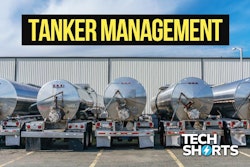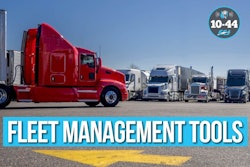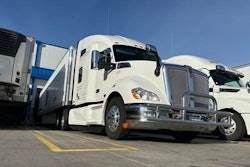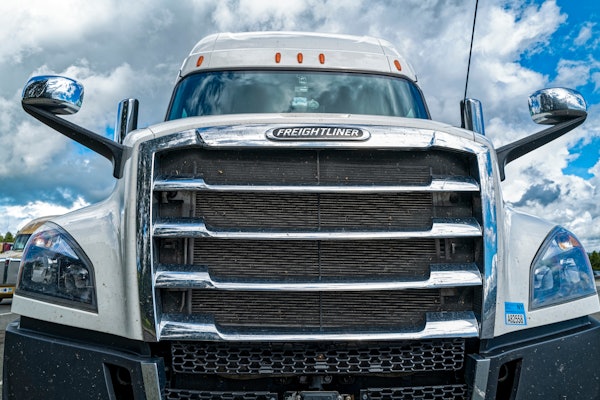In 2015 Freightliner rolled out the first licensed autonomous commercial truck to operate on an open public highway in the U.S., driving it across the Hoover Dam. Autonomous vehicles were all the hype. While the hype of AVs has died down a bit as the industry continues to work out all the kinks with deploying the technology, artificial intelligence has become all the rage, and fleets are dipping their toes in the water.
Telematics and fleet management tools provider Platform Science has been working with large carriers like Schneider, U.S. Express and Walmart as they’ve tested out the AI space, and Chief Technology Officer and Co-founder Jake Fields said smaller fleets should sit back and let the big companies prove things out.
“Not everybody needs to innovate day one on AI, and being a fast follower … has a lot of value to it versus making expensive investments into things that are quite speculative,” he said during McLeod Software’s recent AI conference. “… Don't get too caught up in the hype because we're going to be living in it for a long time.”
Early adopters
Many fleets with dash cameras aren’t strangers to AI. Several providers offer cameras that use AI to track eye movement, for example, to determine if a driver is drowsy and alert them.
There’s AI around gathering data for predictive maintenance as well. But those are third-party solutions. Now, some fleets have begun directly experimenting with AI, implementing simple chatbots for things like driver and customer support by using a large language model to parse its own data for quick responses to common questions.
[RELATED: AI is launching the transportation industry forward]
Fields said this is an easy way for fleets to get started, but he warned that they should be prepared for complaints and driver frustration because the technology is new and imperfect.
The value extends beyond reducing back-office tasks.
“I think one of the more valuable learnings from that approach that we're seeing from some fleets testing that out is the volume and the types of questions they're getting back – questions they didn't really realize the driver had or that were getting lost with the driver manager – so they can really understand their drivers’ needs a little bit better and then expand on that,” he said.
More to come
The many use cases of AI within the trucking industry have yet to be discovered, but Fields said what’s guiding it is identifying problems and finding a way that AI can solve them.
From his perspective, it’s driver-centric – making their lives easier and safer with less cognitive load, allowing them to focus on their job: driving.
“The core goal from my point of view is let drivers drive,” Fields said. “A lot of tasks have been added to the driver’s day, so to the extent that those can get automated, whether it's AI or just software integration that offers a ton of value for them … just keeping an eye out for those opportunities and one by one picking those off.”
But he said the industry shouldn’t have a huge hill to climb as a lot of these technologies are naturally going to evolve from vendors who have already done the development.
[RELATED: Geotab plans rollout of generative AI copilot]
And it’s also beginning to come more from the OEMs.
One thing Fields said fleets can look forward to is OEMs are making technology pilots more accessible. Often a pilot involves six months or more of work just to get started as fleets go through non-disclosure agreements, deciding which vehicles to deploy the technology on and then integrating things. He said they’re now becoming more “push-button” because ease of integration is pertinent if fleets are going to test and deploy these technologies.
“The vehicles are kind of like Steve Jobs’ original iPhone announcement. It was a camera, a phone, an Mp3 player and internet all in one. The vehicle is mobile communications, a display, cameras, microphones. All those technologies are coming into play now where that is going to be a smart truck that you’re operating within,” he said. “Previously that was speculative; now that's happening. So the native connectivity in the vehicles, the in-dash displays, are coming over the next two years with most of the OEMs.”
The in-between
Speaking of OEMs, Fields said Platform Science has been working with them to drive their roadmaps over the coming years to ensure the right technology is built into the new vehicles to allow fleets to adapt – an important step in AI adoption.
“How do we create that continuity path? How do we take a look at what AI technologies and other assistive technologies may come to bear,” he said.
One of those is voice technologies, and there have been many challenges, from the audio perspective to the AI’s capability to answer questions smartly.
[RELATED: New trucking tech company aims to improve driver safety, retention with enhanced communication]
But each of these technologies, whether voice automation or AI in dash cams, don’t stand alone.
“If I'm the driver, I may want to say, ‘How many hours of service do I have remaining when I reach my destination?’ That's a voice engine that needs to tap into a dispatch application that needs to seamlessly speak to a navigation application and an hours-of-service application and optimally do it all without having to talk to the internet,” Fields said, adding that it’s important for all those systems to talk to each other without fragmentation so there is a streamlined path for fleets to then layer value on top.
Platform Science, among other industry vendors, have been creating the fabric for these different applications to work together, whether those are mobile applications or different cloud applications that fleets are deploying.
“We quickly found out through our experience with Schneider and others that it wasn't one solution that was going to solve for everything within a fleet. It needed to be some layer of connective tissue, some way for these different things to work together,” Fields said. “So what we've done from an aftermarket perspective and directly with the OEMs is create that future foundation for how (fleets) can easily deploy technology.”
Then, he said, fleets can layer on AI to solve their problems.












